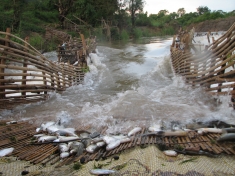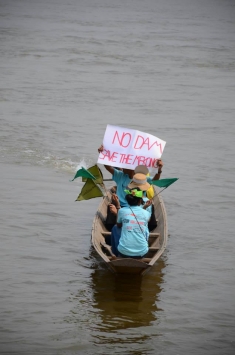Don Sahong Site Visit No Substitute for Regional Consultation

Last week, the government of Laos conducted a second visit to the site of the Don Sahong Dam in southern Laos. The visit appears to be yet another attempt by Laos to sell the Don Sahong Dam to regional governments on its own terms; while the government continues to feign transparency, it's still refusing to submit the project for regional consultation under the Mekong River Commission’s procedures.
The first visit to the Don Sahong Dam site, held in November, resulted in strong concerns being raised by representatives from Cambodia and Vietnam over the project’s transboundary impacts on fisheries and unproven mitigation measures proposed by developers. A special meeting of the Mekong River Commission’s (MRC) Joint Committee that was subsequently held in January to respond to official requests submitted by Cambodia, Thailand and Vietnam for the Don Sahong Dam to undergo regional consultation resulted in a stalemate. As no agreement could be made, the decision over how to proceed with the consultation process has been elevated to a ministerial level. However no date has yet been established for this meeting.
Meanwhile Laos has already started construction on the bridge and access roads at the Don Sahong Dam site, and it was announced at the site visit that “full-scale” construction would start at the beginning of December. The Deputy Minister of Energy and Mines, Viraponh Viravong also announced that the project’s concession agreement had been mapped out and sent to lawmakers for approval. As of yet it has not been made public who will be financing the project.
Cambodia, Thailand and Vietnam have made it clear that they believe the Don Sahong Dam should undergo prior consultation, as laid out under the 1995 Mekong Agreement. The prior consultation process would allow regional governments to review the studies and impacts of the project – including transboundary impacts – within a formal procedural process, in order to attempt to reach regional agreement on how to proceed.
While discussion on the procedural process for the Don Sahong Dam reportedly took a back seat to more technical discussion at the site visit, the position of Laos’ neighbors was made more pronounced by the absence of representatives from the Thai National Mekong Committee. Thai officials also supposedly refused to take part in the first site visit, as they reportedly did want to be seen a supporting the project, and had made their position – calling for prior consultation – clear.
NGOs from Cambodia denounced the site visit, raising concerns about the risks to Cambodia which have yet to be addressed. In a press conference following the trip, Tek Vanarra, the executive director of NGO Forum, said that while the project’s consultant said "he would try to make sure the two channels beside the project will work as alternative fish passages... ‘try’ is not enough...Cambodians depend on the fish from the Hou Sahong channel, which the dam would block.”
The scientific community has added their voice to mounting concerns over the serious transboundary impacts of the Don Sahong Dam. In a scientific review of the project’s Environmental Impact Assessment (EIA) released on March 4, WWF highlights the lack of baseline data presented on fish species and migration patterns, which is imperative to understand and address the threats to fish migration and the impact the dam will have on local and regional fisheries, food security and livelihoods. Much of the project’s success and avoidance of “significant” transboundary impacts is hinging on the adaptive approach to mitigation measures proposed by the developers. However this approach cannot function without comprehensive baseline data, particularly when it comes to measuring and adapting to impacts on fish migration and loss to local and regional fisheries. In a presentation by the Don Sahong Power Company, given at a technical workshop ahead of the site visit, they stated that “there is no quantitative data at all on the proportions of fish that get past the [Khone] falls (in total) or on the proportion that pass each channel at present.” Concluding that, “nobody can quantify fisheries losses at this stage.”
The Don Sahong Dam is located less than 2 km away from the Cambodian border on one of the most important channels in the Mekong River that allows for year-round fish migration. Despite the evident impact of the Don Sahong Dam on Mekong capture fisheries, there is no mention in the EIA of compensation for neighboring countries and no transboundary impact assessment has been carried out. The government of Laos has already failed to compensate fisherman in the Khone Falls area who have been forbidden to fish with traditional Ly traps since they were banned.
When US Secretary of State John Kerry visited the region in December of last year, he spoke at a press conference in Vietnam about the value of a shared Mekong River, saying that “no one country has a right to deprive another country of the livelihood and the ecosystem and its capacity for life itself that comes with that river.”
Unfortunately, the Don Sahong Dam has the potential to do just that.
The recent site visit is a move by Laos to present the project on their own terms, and to minimize, at least rhetorically, the significant impacts of the project. However, a site visit is no substitute for regional consultation and Laos has not, as it claims, “completed its international obligation” with regards to the Don Sahong Dam. If Laos is serious about being open and transparent – and cooperating in the spirit of the 1995 Mekong Agreement – the government would allow the Don Sahong Dam to undergo Prior Consultation through the MRC’s process, creating a space for regional discussion and public participation.



